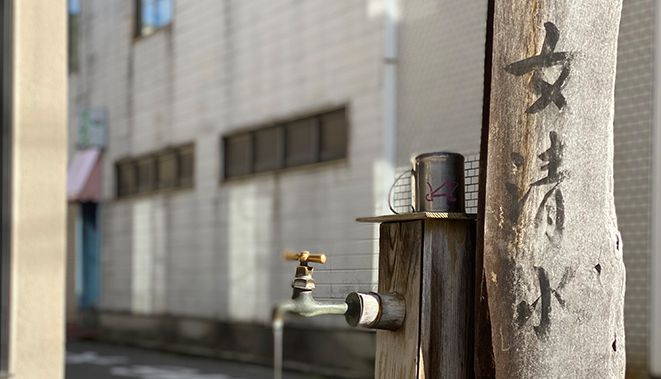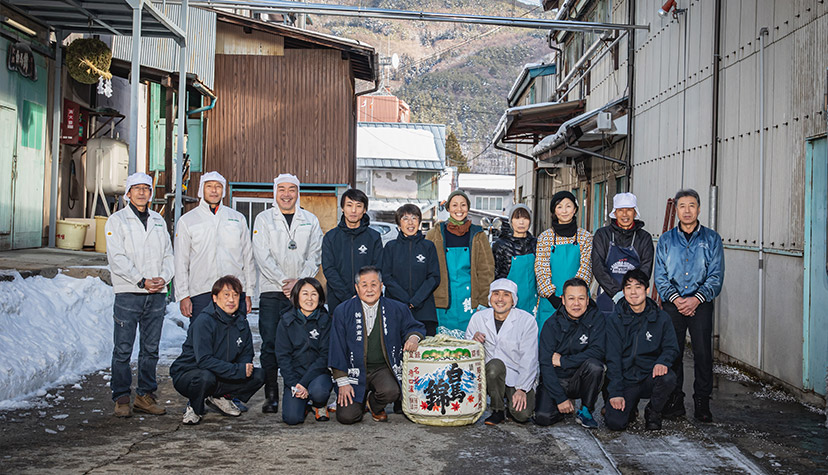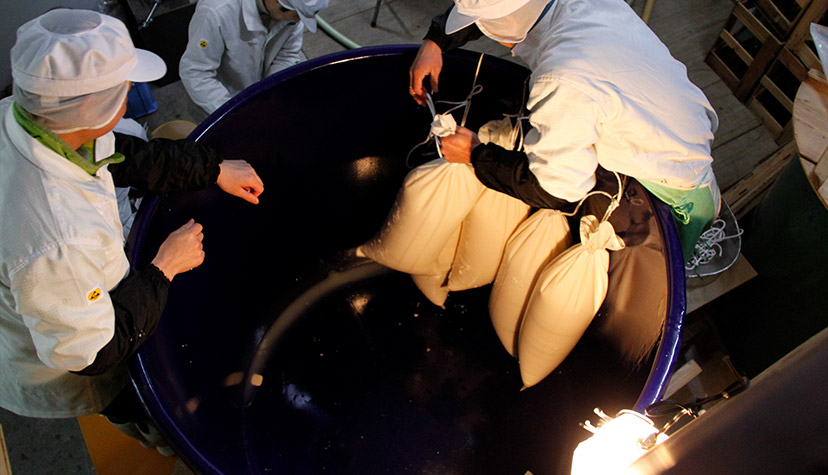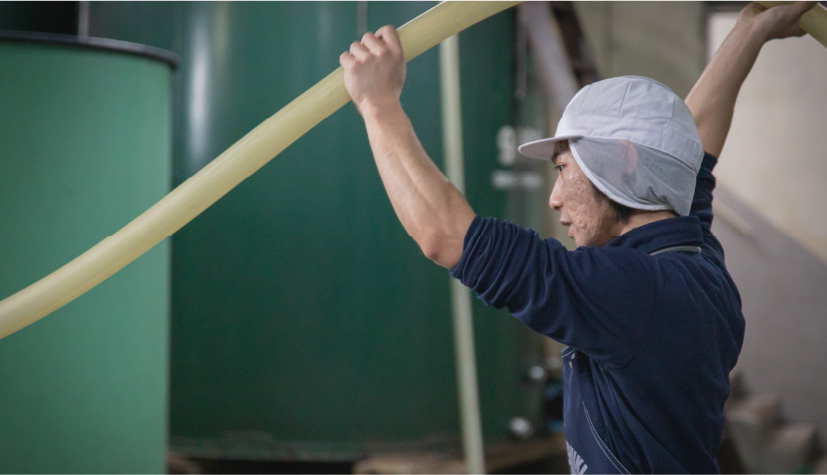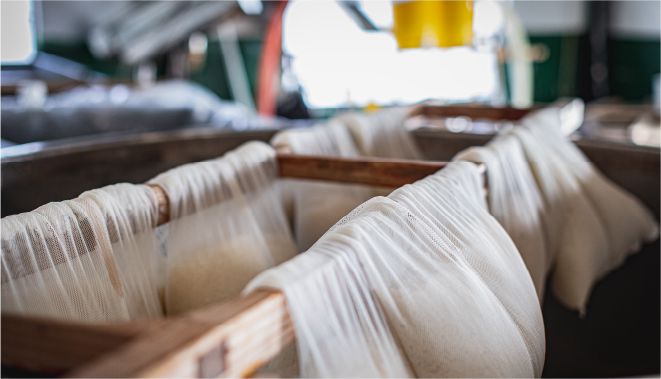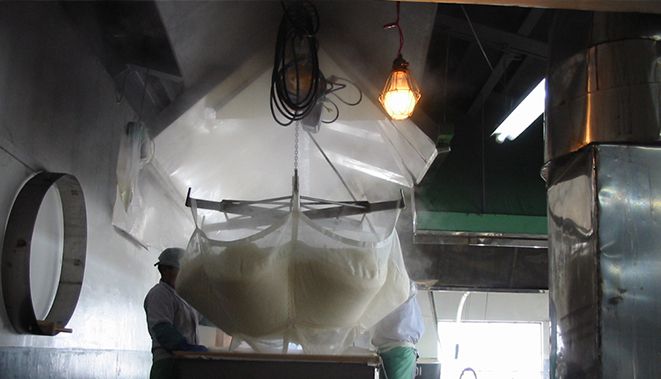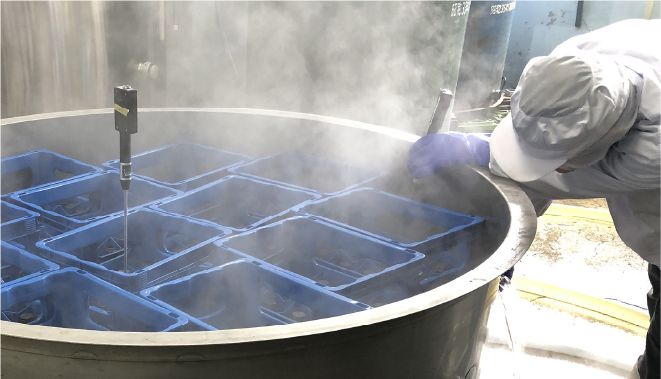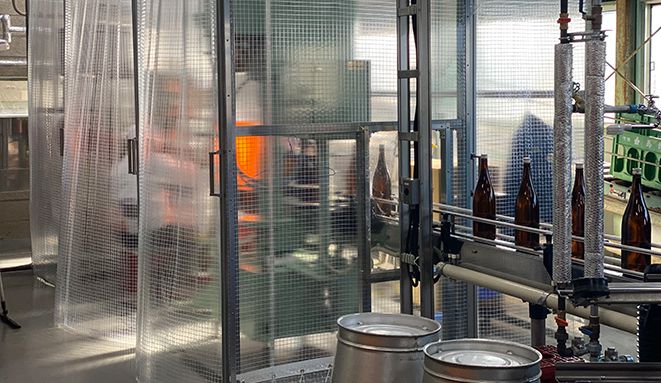Our brewery is located in Omachi City, Nagano Prefecture, at an altitude of about 700m at the base of the Mt.Northern Alps.
Our sake is blessed with rice grown under cultivation in our hometown and limpid water from the mountain.
If you have taste the sake, you must feel beatiful water, mountain, and our feeling.
Our sake is blessed with rice grown under cultivation in our hometown and limpid water from the mountain.
If you have taste the sake, you must feel beatiful water, mountain, and our feeling.
Water
Turn on the tap and you get fresh spring water.
Omachi City, Nagano Prefecture, where Hakuba Nishiki was developed,
is located in a rich natural environment with green dams and natural filtration systems.
The land of Omachi City has excellent water retention capacity and is covered with abundant greenery.
When the rain falls, the plants act as a buffer, preventing landslides and allowing the water to slowly soak into the ground over time.
It is like a natural water filter, filtering rainwater and producing delicious groundwater.
Therefore, Omachi City has no water purification plant.
Only the minimum treatment* required by law for use as tap water is delivered to the people.
*For every 25 m pool of water (3 million litres), one plastic bottle (500 ml) of sodium hypochlorite (chlorine) is added.
Omachi City’s tap water is supplied by four water systems favoured by beautiful rivers.
It is produced from four water systems: the Yazawa, Iyari-ri, Shirasawa and Kamishirasawa water systems respectively.
For example, the water used by shops on the east and west sides of the Omachi shopping street is different.
On the east side, called ‘Onna-mizu’, spring water from Iyari-ri, a village 900 m above sea level, flows into the tap.
、On the west side, called ‘Otoko mizu’,
spring water from Kamishirasawa (upstream of the river at the entrance to the Kurobe Dam) in the Alps at an altitude of nearly 3,000 m flows into the tap respectively.
Hakuba Nishiki’s water source is from the Iyari Marsh in the eastern part of Omachi City.
Of the many water sources in Omachi, this is the softest.
It is clear and soft, and is a key factor in Hakubanishiki’s sake quality.
Omachi City, Nagano Prefecture, where Hakuba Nishiki was developed,
is located in a rich natural environment with green dams and natural filtration systems.
The land of Omachi City has excellent water retention capacity and is covered with abundant greenery.
When the rain falls, the plants act as a buffer, preventing landslides and allowing the water to slowly soak into the ground over time.
It is like a natural water filter, filtering rainwater and producing delicious groundwater.
Therefore, Omachi City has no water purification plant.
Only the minimum treatment* required by law for use as tap water is delivered to the people.
*For every 25 m pool of water (3 million litres), one plastic bottle (500 ml) of sodium hypochlorite (chlorine) is added.
Omachi City’s tap water is supplied by four water systems favoured by beautiful rivers.
It is produced from four water systems: the Yazawa, Iyari-ri, Shirasawa and Kamishirasawa water systems respectively.
For example, the water used by shops on the east and west sides of the Omachi shopping street is different.
On the east side, called ‘Onna-mizu’, spring water from Iyari-ri, a village 900 m above sea level, flows into the tap.
、On the west side, called ‘Otoko mizu’,
spring water from Kamishirasawa (upstream of the river at the entrance to the Kurobe Dam) in the Alps at an altitude of nearly 3,000 m flows into the tap respectively.
Hakuba Nishiki’s water source is from the Iyari Marsh in the eastern part of Omachi City.
Of the many water sources in Omachi, this is the softest.
It is clear and soft, and is a key factor in Hakubanishiki’s sake quality.
Rice
Tomosuke Usui, a fourth-generation owner,
was concerned that the number of farmers was decreasing year by year due to the government’s policy of reducing rice acreage and the difficulty of training young farmers,
and that the number of fallow fields was increasing and the fields were becoming deserted,
He decided that he had to preserve the rural landscape of his beautiful hometown.
It has been more than 30 years since we started to purchase rice under contract,
aiming to preserve the farmers and their fields and to procure high-quality ingredients.
We buy and support contract farmers, improve the quality and make good sake with good ingredients.
It was the origin of Usui Shoten.
We want to use rice that we can see the producer’s face, not rice from an unknown land.”
More than a decade ago, all rice was cultivated under contract,
In 2017, the main sake brewing rice varieties – Miyamanishiki, Hitogokochi,
Kinmonnishiki and Todorokiwase – were grown in a 7 km radius of the brewery,
Twice a year, in spring and autumn, study meetings are held with the brewer,
toji and growers to discuss and improve the quality of the rice for brewing.
Since 2008, the company has adopted environmentally friendly cultivation techniques and all farmers have been certified as ‘Eco Farmers’*,
We have started initiatives to improve soil and prevent water pollution caused by chemical fertilisers.
*Based on the Sustainable Agriculture Law, which was established to promote the introduction of environmentally friendly and sustainable agricultural production methods,
Farmers who have submitted an environmentally friendly agricultural plan to the prefectural governor, such as complying with the appropriate amount of compost and reducing the use of chemical fertilisers and pesticides, and have received certification.
In 2015, they started ‘deep-water cultivation’, which involves filling rice beds with water deeply to ‘further improve’ the quality of the rice.
By deepening the water level after rice planting, extra branches are eliminated and stems are thickened.
This reduces the amount of fertiliser, while at the same time reducing the number of grains of rice per plant and enhancing the quality of each individual grain.
This method is now used in almost all rice production.
Usui Shoten will continue to improve the quality of its rice.
was concerned that the number of farmers was decreasing year by year due to the government’s policy of reducing rice acreage and the difficulty of training young farmers,
and that the number of fallow fields was increasing and the fields were becoming deserted,
He decided that he had to preserve the rural landscape of his beautiful hometown.
It has been more than 30 years since we started to purchase rice under contract,
aiming to preserve the farmers and their fields and to procure high-quality ingredients.
We buy and support contract farmers, improve the quality and make good sake with good ingredients.
It was the origin of Usui Shoten.
We want to use rice that we can see the producer’s face, not rice from an unknown land.”
More than a decade ago, all rice was cultivated under contract,
In 2017, the main sake brewing rice varieties – Miyamanishiki, Hitogokochi,
Kinmonnishiki and Todorokiwase – were grown in a 7 km radius of the brewery,
Twice a year, in spring and autumn, study meetings are held with the brewer,
toji and growers to discuss and improve the quality of the rice for brewing.
Since 2008, the company has adopted environmentally friendly cultivation techniques and all farmers have been certified as ‘Eco Farmers’*,
We have started initiatives to improve soil and prevent water pollution caused by chemical fertilisers.
*Based on the Sustainable Agriculture Law, which was established to promote the introduction of environmentally friendly and sustainable agricultural production methods,
Farmers who have submitted an environmentally friendly agricultural plan to the prefectural governor, such as complying with the appropriate amount of compost and reducing the use of chemical fertilisers and pesticides, and have received certification.
In 2015, they started ‘deep-water cultivation’, which involves filling rice beds with water deeply to ‘further improve’ the quality of the rice.
By deepening the water level after rice planting, extra branches are eliminated and stems are thickened.
This reduces the amount of fertiliser, while at the same time reducing the number of grains of rice per plant and enhancing the quality of each individual grain.
This method is now used in almost all rice production.
Usui Shoten will continue to improve the quality of its rice.
Introduction of sake rice producers
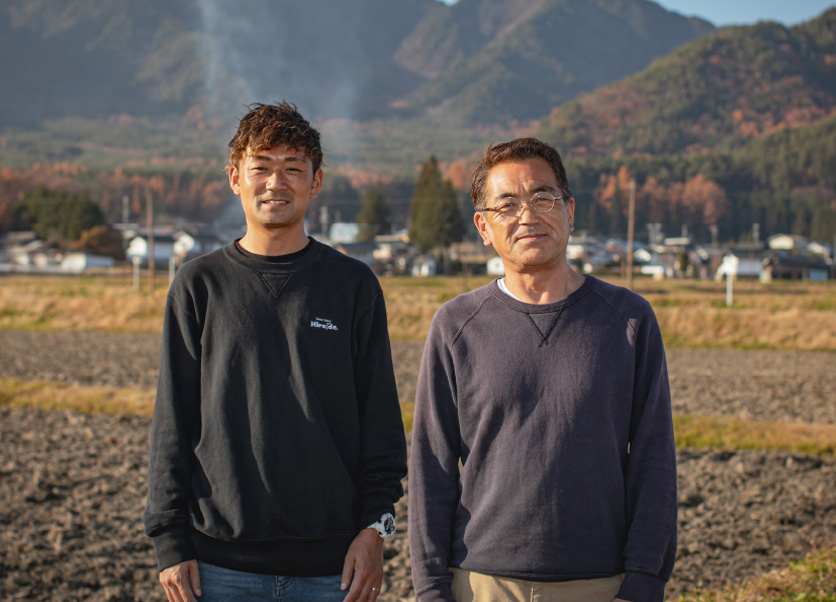
- Omachi City, Nagano Prefecture
Vambert Hiraide Corporation . Mr Toru Hiraide.“Food and community well-being through agriculture.”
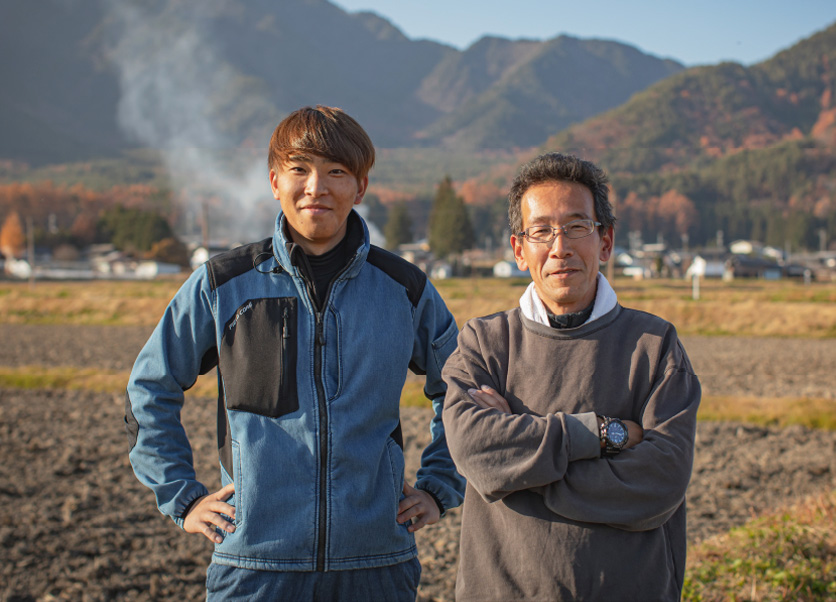
- Omachi City, Nagano Prefecture
Yamaguchi Farm, Mr.Yoichiro Sugasawa.“As a farmer in the area where the water flows from the headwaters, I am grateful for the blessings of the water and carry out honest and diligent farming,We are working to maintain and sustain our farmland and the local community”
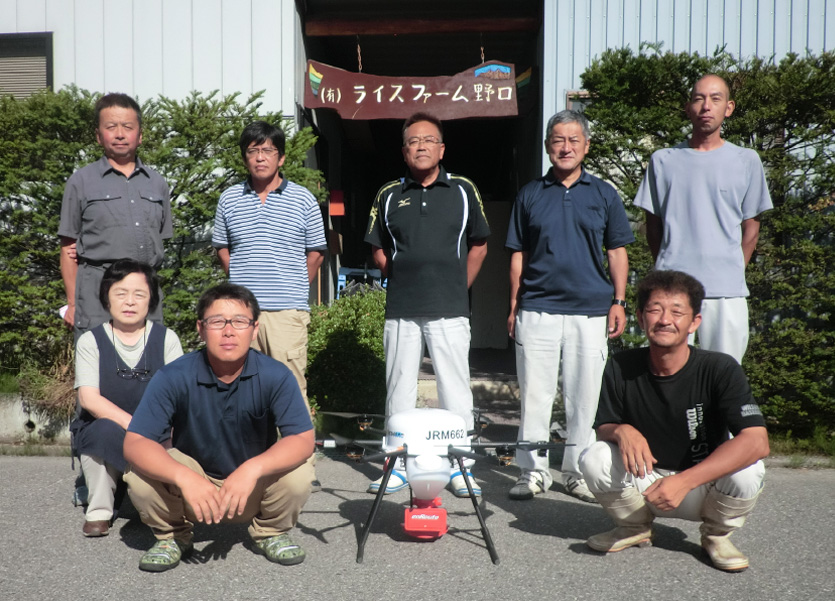
- Omachi City, Nagano Prefecture
Rice Farm Noguchi, Ltd. Mr.Fukushima“Delicious rice directly from the Northern Alps”.
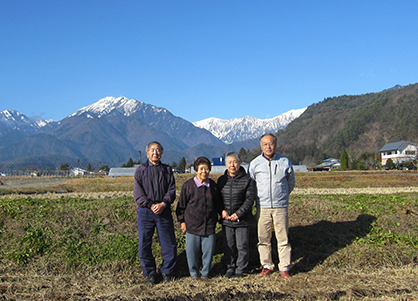
- Omachi City, Nagano Prefecture
Omachi City Flower and Flower Association, Agricultural Cooperative Society Mr. Tasuke Miyazawa“We deliver safe and tasty rice to you.”
Brewers
Toji
(Chief brewer)Hiroyuki Matsuura (Toji)
Born: 11 September 1973
Joined the company: 18 October 1999
Toji Appointed: 2007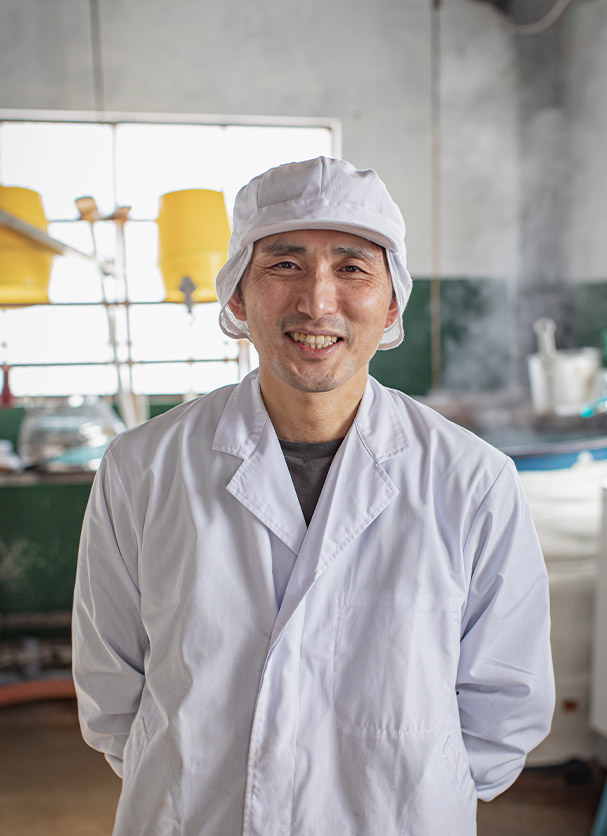
Hakuba Nishiki has been produced mainly by a toji and brewer from Kotani Village, an area with heavy snowfall,
Since the Toji Matsuura took over in 2007, farmers and workers in Omachi City have gradually taken over.
With the exception of the toji, the other brewers are seasonal employees, each with their own day job, who bring their skills and experience to the sake brewing process.
A contract farmer is also a member of the brewery.
Since the Toji Matsuura took over in 2007, farmers and workers in Omachi City have gradually taken over.
With the exception of the toji, the other brewers are seasonal employees, each with their own day job, who bring their skills and experience to the sake brewing process.
A contract farmer is also a member of the brewery.
Brewing
In Omachi, at an altitude of over 750 m, the boiling point is low and even when the water boils,
it does not reach 100 °C.
We use steam heaters to raise the temperature of the steam used to steam the rice,
and we also make sure that the steaming time is long enough.
In winter, the temperature is well below minus 10°C. It is like brewing sake on top of a mountain.
The low temperature and dry air makes the brewery workers feel tighter,
keeps out germs and is the perfect environment for healthy fermentation.
We take care to warm the air so that it is not too cold, even more than to cool it.
The yeasts are purchased from research institutes such as the Japan Brewers Association
and the Nagano Prefectural Industrial Technology Centre,
All our yeasts are cultivated in-house and then used.
it does not reach 100 °C.
We use steam heaters to raise the temperature of the steam used to steam the rice,
and we also make sure that the steaming time is long enough.
In winter, the temperature is well below minus 10°C. It is like brewing sake on top of a mountain.
The low temperature and dry air makes the brewery workers feel tighter,
keeps out germs and is the perfect environment for healthy fermentation.
We take care to warm the air so that it is not too cold, even more than to cool it.
The yeasts are purchased from research institutes such as the Japan Brewers Association
and the Nagano Prefectural Industrial Technology Centre,
All our yeasts are cultivated in-house and then used.
Facility
The Hakubanishiki brewery is located in the middle of the city centre along the Sengoku Highway, known as the ‘salt road’.
It was designed and built in the 1960s by Jiro Shinoda, an architect and sake expert.
The building was designed as a multi-storey structure with three floors, a basement,
a first floor and a second floor, despite the limited site in a densely populated residential area,
The facility is designed in a three-dimensional structure with three floors,
a mezzanine floor, a ground floor and a basement level, so that the amount of material can be efficiently transferred
from the upper floors to the processing of raw materials, brewing and storage.
In particular, the basement is a cool space where the temperature does not reach over 20°C even in mid-summer,
making a contribution to the beneficial maturation of the sake.
In 2020, a high-precision filter, a fire-cooled rapid filling system and a clean room were incorporated,
and the brewery is striving to produce safe, high-quality products.
It was designed and built in the 1960s by Jiro Shinoda, an architect and sake expert.
The building was designed as a multi-storey structure with three floors, a basement,
a first floor and a second floor, despite the limited site in a densely populated residential area,
The facility is designed in a three-dimensional structure with three floors,
a mezzanine floor, a ground floor and a basement level, so that the amount of material can be efficiently transferred
from the upper floors to the processing of raw materials, brewing and storage.
In particular, the basement is a cool space where the temperature does not reach over 20°C even in mid-summer,
making a contribution to the beneficial maturation of the sake.
In 2020, a high-precision filter, a fire-cooled rapid filling system and a clean room were incorporated,
and the brewery is striving to produce safe, high-quality products.



